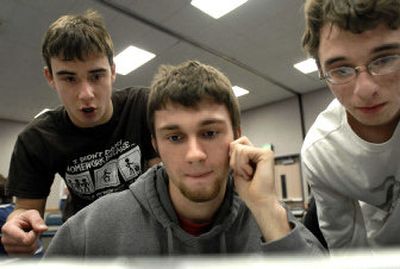Six weeks to build a robot

About 100 high school students who gathered in the Spokane Community College auditorium Saturday along with thousands of their peers from around the world will expend millions of hours of brain power on a shared passion over the next six weeks – and not a single one will be wasted on Paris Hilton.
Instead, they will use their time and brain power creating robots for the 2007 FIRST (For Inspiration and Recognition of Science and Technology) Robotics Competition.
The Inland Northwest students – from Saint George’s School; West, Central and East Valley high schools; and Bonners Ferry High School in North Idaho – watched the kickoff of this year’s competition on a webcast originating in New Hampshire.
Working with mentors, the students have six weeks to design, program, build and test their robots to will be able to compete in this year’s game, “Rack ‘N’ Roll.” Their robots will be able to hang inflated tubes on pegs set up in rows and columns on a 10-foot-high rack structure.
“I look at these robots and still wonder how we’re going to do it. Somehow it’s going to happen,” said Bill Close, East Valley metals and drafting instructor. The students at all the schools will be mentored by local manufacturing and business professionals and instructors from Spokane Community College.
Mike Marzetta, president of Altek Inc., and John Crow, of Lloyd Industries Inc., as well as other members of the Spokane Regional Chamber of Commerce’s Manufacturing Roundtable are promoting the mentoring arrangement.
Crow wants people to say Spokane is a good place to do business because there are so many talented people – not because it has cheap labor. “I want people to say Spokane’s got manufacturing gurus out the wazoo,” said Crow.
This is the rookie year for all the schools except Saint George’s, which is in its third year of competition. In 2005 its team won the regional competition and made it to the finals in Atlanta.
“Going to Atlanta was amazing. Seeing all the ideas, the different strategies. One of the best parts is that the judges go around and talk with the kids to find out what they did and talk to them about their work,” said Rick DeFord, the physics teacher and team adviser at Saint George’s.
DeFord said that kids are star-struck with people like Dean Kamen, founder of FIRST and the inventor of the Segway personal transporter, and Steve Wozniak, co-founder of Apple Computers, and other renowned engineers and technology professionals. “This creates heroes and role models who are real people doing real things,” said DeFord.
Starting a team is expensive. The kit that the robots are made from costs $5,000, and the entry fee is $1,000.
Central Valley and West Valley schools received $6,000 NASA grants to get started. East Valley School District came up with its own financing, and Bonners Ferry received funds from NASA, an Idaho Space grant and the M.J. Murdock Charitable Trust.
Ed Katz, team adviser and science teacher for Bonners Ferry, said he had no trouble recruiting team members. “I hoped to work with eight to 10 students on a regular basis. Instead I had 30 kids show up the first couple meetings, and I’m continuing to get about 20,” he said. “That was surprising since we’re only a school of about 500 students. That’s a lot of interest.”
The interest isn’t just from guys. For the past two years, Elisabeth DeLeeuw was the only girl on Saint George’s team. This year five more have joined. She has seen a lot of other changes.
“We had no experience at school or in the classroom with engineering or technology when we started. We were in way over our heads, and we didn’t know it. After we won regionals and saw what we could do – that was the turning point. Since then it’s all about what can we do to spread the word,” said DeLeeuw.
As the veteran team, Saint George’s has offered to answer questions and help the new schools get started. One of the themes of this competition is “gracious professionalism.”
“It’s all about working with people instead of against them. We don’t see new teams as competition, but as teams from our region,” said DeLeeuw. “I’m so excited that these kids in the other schools are going to be able to learn about this.”
The competition offers something for everyone. Bonners Ferry senior Jeff Howard is interested in the knowledge he’ll gain working on the robotics team, but he has a different role. “I’m the PR guy. I’m planning on majoring in marketing,” he said.
Students learn to do public speaking and make presentations, not in front of other students but in front of corporate executives.
“I attribute my public speaking skills to this program. Before I joined the robotics team I was afraid to call and order a pizza. All of a sudden I’m calling CEOs to see if they want to donate a couple thousand dollars to help high school kids build a robot,” said DeLeeuw.